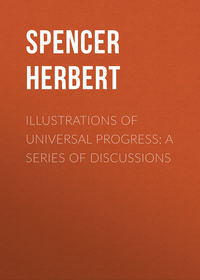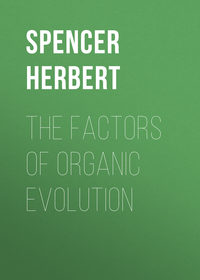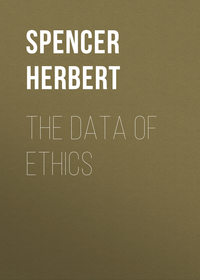 полная версия
полная версияFirst Principles
CHAPTER XII.
THE CONDITIONS ESSENTIAL TO EVOLUTION
§ 100. One more preliminary is needful before proceeding. We have still to study the conditions under which alone, Evolution can take place.
The process to be interpreted is, as already said, a certain change in the arrangement of parts. That increase of heterogeneity commonly displayed throughout Evolution, is not an increase in the number of kinds of ultimate or undecomposable units which an aggregate contains; but it is a change in the distribution of such units. If it be assumed that what we call chemical elements, are absolutely simple (which is, however, an hypothesis having no better warrant than the opposite one); then it must be admitted that in respect to the number of kinds of matter contained in it, the Earth is not more heterogeneous at present than it was at first – that in this respect, it would be as heterogeneous were all its undecomposable parts uniformly mixed, as it is now, when they are arranged and combined in countless different ways. But the increase of heterogeneity with which we have to deal, and of which alone our senses can take cognizance, is that produced by the passage from unity of distribution to variety of distribution. Given an aggregate consisting of several orders of primitive units that are unchangeable; then, these units may be so uniformly dispersed among each other, that any portion of the mass shall be like any other portion in its sensible properties; or they may be so segregated, simply and in endless combinations, that the various portions of the mass shall not be like each other in their sensible properties. A transformation of one of these arrangements into the other, is that which constitutes Evolution. We have to analyze the process through which structural uniformity becomes structural multiformity – to ascertain how the originally equal relations of position among the mixed units, pass into relations of position that are more and more unequal, and more and more numerous in their kinds of inequality; and how this takes place throughout all the ascending grades of compound units, until we come even to those of which societies are made up.
Change in the relations of position among the component units, simple or complex, being the phenomenon we have to interpret; we must first inquire what are the circumstances which prevent its occurrence, and what are the circumstances which facilitate it.
§ 101. The constituents of an aggregate cannot be re-arranged, unless they are moveable: manifestly, they must not be so firmly bound together that the incident force fails to alter their positions. No bodies are, indeed, possessed of this absolute rigidity; since an incident force in being propagated through a body, always produces temporary alterations in the relative positions of its units, if not permanent alterations. It is true also, that even permanent re-arrangements of the units may be thus wrought throughout the interiors of comparatively dense masses, without any outward sign: as happens with certain crystals, which, on exposure to sunlight, undergo molecular changes so great as to alter their planes of cleavage. Nevertheless, since total immobility of the parts must totally negative their re-arrangement; and since that comparative immobility which we see in very coherent matter, is a great obstacle to re-arrangement; it is self-evident that Evolution can be exhibited in any considerable degree, only where there is comparative mobility of parts. On the other hand, those definite distributive changes which constitute Evolution, cannot be extensively or variously displayed, where the mobility of the parts is extreme. In liquids, the cohesion of the units is so slight that there is no permanency in their relations of position to each other. Such re-arrangement as any incident force generates, is immediately destroyed again by the momentum of the constituents moved; and so, nothing but that temporary heterogeneity seen in circulating currents, can be produced. The like still more obviously holds of gases. Thus, while the theoretical limits between which Evolution is possible, are absolute immobility of parts and absolute mobility of parts; we may say that practically, Evolution cannot go on to any considerable extent where the mobility is very great or very little. A few examples will facilitate the realization of this truth.
The highest degrees of Evolution are found in semi-solid bodies, or bodies that come midway between the two extremes specified. Even semi-solid bodies of the inorganic class, exhibit the segregation of mixed units with comparative readiness: witness the fact to which attention was first drawn by Mr. Babbage, that when the pasty mixture of ground flints and kaolin, prepared for the manufacture of porcelain, is kept some time, it becomes gritty and unfit for use, in consequence of the particles of silica separating themselves from the rest, and uniting together in grains; or witness the fact known to every housewife, that in long-kept currant-jelly the sugar takes the shape of imbedded crystals. While throughout the immense majority of the semi-solid bodies, namely, the organic bodies, the proclivity to a re-arrangement of parts is so comparatively great, as to be usually taken for a distinctive characteristic of them. Among organic bodies themselves, we may trace contrasts having a like significance. It is an accepted generalization that, other things equal, the rate of Evolution is greatest where the plasticity is most marked. In that portion of an egg which displays the formative processes during the early stages of incubation, the changes of arrangement are more rapid than those which an equal portion of the body of a hatched chick undergoes. As may be inferred from their respective powers to acquire habits and aptitudes, the structural modifiability of a child is greater than that of an adult man; and the structural modifiability of an adult man is greater than that of an old man: contrasts which are accompanied by corresponding contrasts in the densities of the tissues; since the ratio of water to solid matter diminishes with advancing age. The most decisive proof, however, is furnished by those marked retardations or arrests of organic change, that take place when the tissues suffer a great loss of water. Certain of the lower animals, as the Rotifera, may be rendered apparently lifeless by desiccation, and will yet revive when wetted: as their substance passes from the fluid-solid to the solid state, it ceases to be the seat of those changes which constitute functional activity and cause structural advance; and such changes recommence as their substance passes from the solid to the fluid-solid state. Analogous instances occur among much higher animals. When the African rivers which it inhabits are dried up, the Lepidosiren remains torpid in the hardened mud, until the return of the rainy season brings water. Humboldt states that during the summer drought, the alligators of the Pampas lie buried in a state of suspended animation beneath the parched surface, and struggle up out of the earth as soon as it becomes humid. Now though we have no proof that these partial arrests of vital activity, are consequent on the reduction of the fluid-solid tissues to a more solid form; yet their occurrence along with a cessation in the supply of water, is reason for suspecting that this is the case. And similarly, though in the more numerous instances where loss of water leads to complete arrest of vital activity, we are unable to say that the immediate cause is a stoppage of molecular changes that results from a diminution of molecular mobility; yet it seems not improbable that this is the rationale of death by thirst.
Probably few will expect to find this same condition to Evolution, illustrated in aggregates so widely different in kind as societies. Yet even here it may be shown that no considerable degree of Evolution is exhibited, where there is either great mobility of the parts, or great immobility of them. In such tribes as those inhabiting Australia, we see extremely little cohesion among the units: there is neither that partial fixity of relative positions which results from the commencement of agriculture, nor that partial fixity of relative positions implied by the establishment of social grades. And along with this want of cohesion, we find an absence of permanent differentiations. Conversely, in societies of the oriental type, where accumulated traditions, laws, and usages, and long-fixed class-arrangements, exercise great restraining power over individual actions, we find Evolution almost stopped. Through the medium of institutions and opinions, the forces brought to bear on each unit by the rest, are so great as to prevent the units from sensibly yielding to forces tending to re-arrange them. The condition most favourable to increase of social heterogeneity, is a medium coherence among the parts – a moderate facility of change in the relations of citizens, joined with a moderate resistance to such change – a considerable freedom of individual actions, qualified by a considerable restraint over individual actions – a certain attachment to pre-established arrangements, and a certain readiness to be impelled by new influences into new arrangements – a compromise between fixity and unfixity such as that which we, perhaps as much as any nation, exhibit.
§ 102. Another condition to Evolution, of the same order as the last though of a different genus, must be noted. We have found that permanent re-arrangement among the units of an aggregate, can take place only when they have neither extreme immobility nor extreme mobility. The mobility and immobility thus far considered (at least in all aggregates except social ones) are those due to mechanical cohesion. There is, however, what we must call chemical cohesion, which also influences the mobility of the units, and consequently the re-arrangement of them. Manifestly, if two or more kinds of units contained in any aggregate, are united by powerful affinities, an incident force, failing to destroy their cohesions, will not cause such various re-arrangements as it would, could it produce new chemical combinations as well as new mechanical adjustments. On the other hand, chemical affinities that are easily overcome, must be favourable to multiplied re-arrangements of the units.
This condition, as well as the preceding one, is fulfilled in the highest degree, by those aggregates which most variously display the transformation of the uniform into the multiform. Organic bodies are on the average distinguished from inorganic bodies, by the readiness with which the compounds they consist of undergo decomposition, and recomposition: the chemical cohesions of their components are so comparatively small, that small incident forces suffice to overcome them and cause transpositions of the components. Further, between the two great divisions of organisms, we find a contrast in the degree of Evolution co-existing with a contrast in the degree of chemical modifiability. As a class, the nitrogenous compounds are peculiarly unstable; and, speaking generally, these are present in much larger quantities in animal tissues than they are in vegetal tissues; while, speaking generally, animals are much more heterogeneous than plants.
Under this head it may be well also to point out that, other things equal, the structural variety which is possible in any aggregate, must bear a relation to the number of kinds of units contained in the aggregate. A body made up of units of one order, cannot admit of so many different re-arrangements, as one made up of units of two orders. And each additional order of units must increase, in a geometrical proportion, the number of re-arrangements that may be made.
§ 103. Yet one more condition to be specified, is the state of agitation in which the constituents of an aggregate are kept. A familiar expedience will introduce us to this condition. When a vessel has been filled to the brim with loose fragments, shaking the vessel causes them to settle down into less space, so that more may be put in. And when among these fragments, there are some of much greater specific gravity than the rest, these will, in the course of a prolonged shaking, find their way to the bottom. What now is the meaning of these two results, when expressed in general terms? We have a group of units acted on by an incident force – the attraction of the Earth. So long as these units are not agitated, this incident force produces no changes in their relative positions; agitate them, and immediately their loose arrangement passes into a more compact arrangement. Again, so long as they are not agitated, the incident force cannot separate the heavier units from the lighter; agitate them, and immediately the heavier units begin to segregate. By these illustrations, a rude idea will be conveyed of the effect which vibration has in facilitating those re-arrangements which constitute Evolution. What here happens with visible units subject to visible oscillations, happens also with invisible units subject to invisible oscillations.
One or two cases in which these oscillations are of mechanical origin, may first be noted. When a bar of steel is suspended in the magnetic meridian, and repeatedly so struck as to send vibrations through it, it becomes magnetized: the magnetic force of the Earth, which does not permanently affect it while undisturbed, alters its internal state when a mechanical agitation is propagated among its particles; and the alteration is believed by physicists, to be a molecular re-arrangement. It may be fairly objected that this re-arrangement is hypothetical; and did the fact stand alone, it would be of little worth. It gains significance, however, when joined with the fact that in the same substance, long-continued mechanical vibrations are followed by molecular re-arrangements that are abundantly visible. A piece of iron which, when it leaves the workshop, is fibrous in structure, will become crystalline if exposed to a perpetual jar. Though the polar forces mutually exercised by the atoms, fail to change their disorderly arrangement into an orderly arrangement while the atoms are relatively quiescent, these forces produce this change when the atoms are kept in a state of intestine disturbance.
But the effects which visible oscillations and oscillations sensible to touch, have in facilitating the re-arrangement of parts by an incident force, are insignificant compared with the effects which insensible oscillations have in aiding such change of structure. It is a doctrine now generally accepted among men of science, that the particles of tangible matter, as well as the particles of ether, undulate. As interpreted in conformity with this doctrine, the heat of a body is simply its state of molecular motion. A mass which feels cold, is one having but slight molecular motion, and conveying but slight molecular motion to the surrounding medium or to the hand touching it. A mass hot enough to radiate a sensible warmth, is one of which the more violently agitated molecules, communicate increased undulations to the surrounding ethereal medium; while the burn inflicted by it on the skin, is the expression of increased undulations of the organic molecules. Such further heat as produces softening and a consequent distortion of the mass, is an agitation so much augmented that the units can no longer completely maintain their relative positions. Fusion is an agitation so extreme, that the relative positions of the units are changeable with ease. When, finally, at a still higher temperature, the liquid is transformed into a gas, the explanation is, that the oscillations are so violent as to overbalance that force which held the units in close contiguity – so violent as to keep the units at those relatively great distances apart to which they are now thrown. Since the establishment of the correlation between heat and motion first gave probability to this hypothesis, it has been receiving various confirmations – especially by recent remarkable discoveries respecting the absorption of heat by gases. Prof. Tyndall has proved that the quantity of heat which any gas takes up from rays of heat passing through it, has a distinct relation to the complexity of the atoms composing the gas. The simple gases abstract but little; the gases composed of binary atoms abstract, say in round numbers, a hundred times as much; while the gases composed of atoms severally containing three, four, or more simple ones, abstract something like a thousand times as much. These differences Prof. Tyndall regards as due to the different abilities of the different atoms to take up, in the increase of their own undulations, those undulations of the ethereal medium which constitute heat – an interpretation in perfect accordance with the late results of spectrum-analysis; which go to show that the various elementary atoms, when in an aeriform state, intercept those luminiferous vibrations of the ether which are in unison or harmony with their own. And since it holds of solid as of gaseous matters, that those consisting of simple units transmit heat far more readily than those consisting of complex units; we get confirmation of the inference otherwise reached, that the units of matter in whatever state of aggregation they exist, oscillate, and that variations of temperature are variations in the amounts of their oscillations.
Proceeding on this hypothesis, which it would be out of place here to defend at greater length, we have now to note how the re-arrangement of parts is facilitated by these insensible vibrations, as we have seen it to be by sensible vibrations. One or two cases of physical re-arrangement may first be noted. When some molten glass is dropped into water, and when its outside is thus, by sudden solidification, prevented from partaking in that contraction which the subsequent cooling of the inside tends to produce; the units are left in such a state of tension, that the mass flies into fragments if a small portion of it be broken off. But now, if this mass be kept for a day or two at a considerable heat, though a heat not sufficient to alter its form or produce any sensible diminution of hardness, this extreme brittleness disappears: the component particles being thrown into greater agitation, the tensile forces are enabled to re-arrange them into a state of equilibrium. An illustration of another order is furnished by the subsidence of fine precipitates. These sink down very slowly from solutions that are cold; while warm solutions deposit them with comparative rapidity. That is to say, an increase of molecular vibration throughout the mass, allows the suspended particles to separate more readily from the particles of fluid. The effect of heat on chemical re-arrangement is so familiar, that examples are scarcely needed. Be the substances concerned gaseous, liquid, or solid, it equally holds that their chemical unions and disunions are aided by a rise of temperature. Affinities which do not suffice to effect the re-arrangement of mixed units that are in a state of feeble agitation, suffice to effect it when the agitation is raised to a certain point. And so long as this molecular motion is not great enough to prevent those chemical cohesions which the affinities tend to produce, increase of it gives increased facility of chemical re-arrangement.
This condition, in common with the preceding ones, is fulfilled most completely in those aggregates which exhibit the phenomena of Evolution in the highest degree; namely, the organic aggregates. And throughout the various orders and states of these, we find minor contrasts showing the relation between amount of molecular vibration and activity of the metamorphic changes. Such contrasts may be arranged in the several following groups. Speaking generally, the phenomena of Evolution are manifested in a much lower degree throughout the vegetal kingdom than throughout the animal kingdom; and speaking generally, the heat of plants is less than that of animals. Among plants themselves, the organic changes vary in rate as the temperature varies. Though light is the agent which effects those molecular changes causing vegetal growth, yet we see that in the absence of heat, such changes are not effected: in winter there is enough light, but the heat being insufficient, plant-life is suspended. That this is the sole cause of the suspension, is proved by the fact that at the same season, plants contained in hot-houses, where they receive even a smaller amount of light, go on producing leaves and flowers. A comparison of the several divisions of the animal kingdom with each other, shows among them parallel relations. Regarded as a whole, vertebrate animals are higher in temperature than invertebrate ones; and they are as a whole higher in organic activity and development. Between subdivisions of the vertebrata themselves, like differences in the state of molecular vibration, accompany like differences in the degree of evolution. The least heterogeneous of the vertebrata are the fishes; and in most cases, the heat of fishes is nearly the same as that of the water in which they swim: only some of them being decidedly warmer. Though we habitually speak of reptiles as cold-blooded; and though they have not much more power than fishes of maintaining a temperature above that of their medium; yet since their medium (which is, in the majority of cases, the air of warm climates) is on the average warmer than the medium inhabited by fishes, the temperature of the class of reptiles is higher than that of the class of fishes; and we see in them a correspondingly higher complexity. The much more active molecular agitation in mammals and birds, is associated with a considerably greater multiformity of structure and a very much greater vivacity. And though birds, which are hotter blooded than mammals, do not show us a greater multiformity; yet, judging from their apparently greater locomotive powers, we may infer more rapid functional changes, which, equally with structural changes, imply molecular re-arrangement. The most instructive contrasts, however, are those presented by the same organic aggregates at different temperatures. Thus we see that ova undergoing development, must be kept more or less warm – that in the absence of a certain molecular vibration, the re-arrangement of parts does not go on. We see, again, that in hybernating animals, loss of heat carried to a particular point, results in extreme retardation of the organic changes. Yet further, we see that in animals which do not hybernate, as in man, prolonged exposure to extreme cold, produces an irresistible tendency to sleep (which implies a lowering of the functional activity); and then, if the abstraction of heat continues, this sleep ends in death, or arrest of functional activity. Lastly, we see that when the temperature is lowered till the contained water solidifies, there is a stoppage not only of those molecular re-arrangements which constitute life and development, but also of those molecular re-arrangements which constitute decomposition.
Evidently then, both sensible and insensible agitations among the components of an aggregate, facilitate any re-distributions to which there may be a tendency. When that rhythmic change in the relative positions of the units which constitutes vibration, is considerable, the relative positions of the units more readily undergo permanent changes through the action of incident forces.
§ 104. These special conditions to Evolution, are clearly but different forms of one general condition. The abstract proposition, that a permanent re-arrangement of units is possible only when they have neither absolute immobility nor absolute mobility with respect to each other, we saw to be practically equivalent to the proposition, that extreme cohesion and extreme want of cohesion among the units are unfavourable to Evolution. Be this cohesion or want of cohesion that which physically characterizes the matter as we ordinarily know it; be it that cohesion or want of cohesion distinguished as chemical; or be it that cohesion or want of cohesion consequent on the degree of molecular vibration; matters not, in so far as the general conclusion is concerned. Inductively as well as deductively, we find that the genesis of such permanent changes in the relative positions of parts, as can be effected without destroying the continuity of the aggregate, implies a medium stability in the relative positions of the parts: be this stability physical, chemical, or that which varies with the state of agitation. And as might be anticipated à priori, it is proved à posteriori, that this re-arrangement of parts goes on most actively in those aggregates whose units are moderately influenced by all these forces which affect their mobility.









